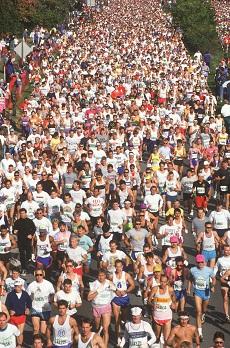
 |
| MarcioSilva/Dreamstime.com |
If it takes a village to raise a child, it takes a city to host a marathon. In addition to the actual 26.2 miles of streets, it takes a year-long coordinated effort between city services, event organizers, and of course, volunteers and spectators to put on an event that people will flock to annually and bring their millions of tourism dollars with them.
It takes a tremendous marketing and public relations effort to both educate and inspire a community about a major running event that’s coming to their particular city. If done correctly, the effort can influence citizens to get involved. However if the critical component is ignored, thousands of citizens’ voices calling City Hall is enough to bring any event to an abrupt halt.
So what's the best way to get people to rally behind an event? Our firm, Corrigan Sports Enterprises (CSE), owns and operates numerous popular running events across the country, including the Baltimore Running Festival since 2001. This past October, the event attracted 26,000 runners from all 50 states and two dozen countries to participate in a marathon, half-marathon, four-person relay, 5K and kids' fun run. Given that kind of success, we would like to share with you the things we do to get spectators excited and keep them happy.
 It's All in the Approach
It's All in the Approach
Success at the finish line calls for an intense, a multi-pronged marketing and public relations approach geared toward both runners and non-runners. That approach starts early. We call it "hitting the fast-forward button." In other words, the event may be months off, but we have to start engaging early in order to build excitement.
For us, it’s essential to educate the community to let them know we are coming and give them first-hand information about what they can do to be a part of the day. Case in point: Rather than allowing people to have the misperception the event will paralyze the city’s traffic for an entire day, we give them options about how to plan their route that day, or even better, encourage them to set up a cheer station in their neighborhood.
One of the greatest tools we use to do this is our Runner Time Chart. If someone calls us and is worried about traffic because of the marathon, we first find out where along the route that person lives. If that person lives around mile10, and the race begins at 8 a.m., we can estimate the fastest runners should be in that neighborhood shortly before 9 a.m. The slower runners will follow, and if there are any people who have dropped back to walking, and you assume they're doing a 15-minute mile, you can estimate they will be in the neighborhood by around 10:30 a.m. Chances are, everyone will be out of their neighborhood by 10:45 a.m. to 11 a.m., and the clean-up crew will be on its way through.
 Channeling That Home-Town Spirit
Channeling That Home-Town Spirit
The most critical component we've learned to tap into for a host city is the civic pride residents take in living, working and playing along the course they call home. Rather than set up a course that only features the high-profile parts of town, for example, the Baltimore Marathon is deliberately designed to wind through as much of the city as possible, including residential areas of various types, so runners get a first-hand experience about its diverse neighborhoods and local citizens. If residents see that we want runners to experience the true Baltimore, they become even more supportive of the event.
We build awareness by working with local professional sports teams. The Baltimore Orioles host Marathon Night, where the team offers discounted tickets to runners for a select home game. During the marathon, there are themed miles along the course. For example, mile 8 is the “Ripken Mile” in honor of Baltimore Orioles Hall-of-Famer Cal Ripken, Jr. who wore #8.
As events return year after year, event organizers get to see evolution in the making in terms of spectator support. Local traditions emerge and take on a life of their own. The running community enjoys the enthusiastic -- and sometimes offbeat -- audience participation. From individuals handing out gummy bears, to a guy dressed in a tiger suit jumping up and down to the song, “Eye of the Tiger,” the folks on the sideline provide the extra energy (and even entertainment) that marathoners need to help propel them to the finish line.
 |
| Marcio Silva/Dreamstime.com |
It's easy to write that, but when participants actually say that, it means even more. We saw a posting on our event's Facebook page from Rus Vanwestervelt, a first-time runner and participant in the half-marathon:
“I can't thank BRF enough for making my first half-marathon experience so life-changing. I started a journey six months ago on April 15 when I weighed in at 317 pounds, unable to walk 1/3 of a mile without having to stop from back pain and being breathless. I made my mind up that I was going to work as hard as I could to finish the half-marathon. I was a back-of-the-pack runner, and every single person along the course made me feel like I was leading the pack and winning the race.”
Giving people a financial boost doesn’t hurt either. The Baltimore Running Festival, like most major races, engages charity groups who use the event as a platform to raise money for their cause. Nearly 30 charity groups raised an event-record $1.7 million in 2012. The positive vibe created by fund raisers is another important component in gaining spectator support.
 |
| Americanspirit/Dreamstiime.com |
Large cheering stations always accompany these charity groups. Fans bring posters, cowbells, and other various noise makers to help cheer not only the runners in their charity group, but all runners on the course.
Getting The Word Out
CSE still utilizes traditional techniques such as old-fashioned door-to-door advertising. During race week they distribute a “Marathon 101” brochure to all the communities affected by the race route. The brochure contains a map and gives citizens tips about how to get involved.
Just like most facets of today’s society, technology can also play a key role in improving a spectator’s experience. The million-dollar question spectators want to know while attending a running event is where their favorite runner is on the course at any given time. Thanks to recent advancement in technology, they can now track a runner via text messaging, e-mail and social media.
 |
| Jonathan Herrero/Dreamstime.com |
The same timing mats used to record a runner’s times are integrated into an overall runner tracking system. When a runner crosses over a mat on the course, an electronic message is generated that details the runner’s location, pace and projected finish time. Now, a spectator knows when to be at the finish line to congratulate their favorite runner as opposed to having to stand and wait there for several hours.
Like many event management teams, we have upped our use of Facebook. We can promote the opening of registration, and keep people updated on our numbers. After the event, we were able to let people know about the chance to purchase leftover BRF merchandise. We can also read comments, hear people's concerns and complaints, and let them know they'll be addressed.
Keeping Sponsors Supportive
It’s also beneficial to incorporate local sponsors when possible. Since 2008, we have teamed up with asset management firm Legg Mason to conduct a School Spirit Award contest. Legg Mason will award a total of $5,000 to the Baltimore City elementary schools that display the most spirit and enthusiasm in cheering the runners as they pass along the course. The schools are judged anonymously by a small group of runners.
Get your information out early and keep it coming. It's the best way to draw spectator interest. Marathons are a prime example. Where else can you witness people cheering complete strangers running down their streets at eight in the morning? We know we've done our job when we see that the local citizens getting enthusiastic about the event and cheering out of respect for anyone who can endure the grueling 26.2 mile test of endurance.

